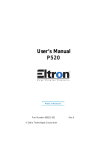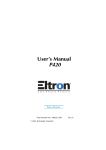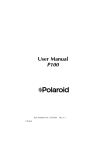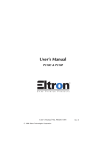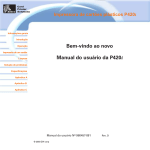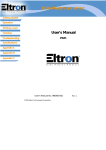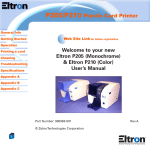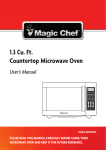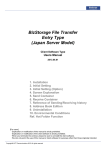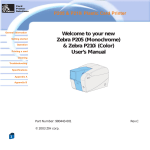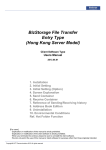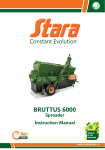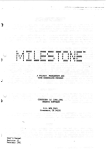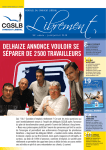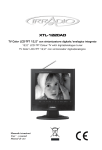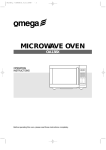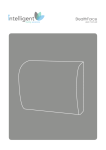Download the PDF file
Transcript
8VHU¶V0DQXDO .237,0$ ©1999 CIM S.p.A. Rev. A FOREWORD This manual contains installation and operation information for the Series card printe rs manufactured by CIM. CIM K500 Optima RETURN MATERIALS AUTHORIZATION Before returning a ny equipment to CIM S.p.A. for in-warranty or out-of-warranty repair, contact Repair Administration for a Return Materials Authorization (RMA) number. Repack the equipment in the original pa cking material and mark the RMA number clearly on the outside. Ship the equipment, freight prepaid, to the address listed below: COPYRIGHT NOTICE This document contains information proprietary to CIM S.p.A. This document and the information contained within are Copyrighted by CIM S.p.A. and may not be duplicated in full or in pa rt by any person without written approval from CIM. While every e ffort has been made to keep the information contained within cu rrent and accurate as of the date of publication, no guarantee is given that the document is error-free or that it is accurate with regard toany specification. CIM reserves the right to ma ke changes, for the purpose of product improvement, at any time. TRADEMARKS K 500 Optima is a service mark and CIM is a registered trademark of CIM S.p.A. Windows and MS.DOS are registered trademarks of Microso ft Corp. All other trademarks or registered trademarks are marks of their respect ive holde rs. iii iii WARRANTY INFORMATION WE NEED TO HEAR FROM YOU! To establish your warranty period and provide access to technical support, send us your warranty registration card today! CIM warrants the mechanism, control electronics and power supply, under normal use and service, to be free from defects in material and workmanship for a period of twelve (12) months from the date of purchase by the end user. If proof of purchase or product registration cannot be established, shipment date to the original buyer (dealer or distributor) will be used to establish the warranty period. Failure to exercise caution to protect the equipment from electrostatic discharge damage, adverse temperature and humidity conditions or physical abuse, including, but not limited to, improper packaging, shipping, service or repairs performed by personnel not authorized by CIM may void the warranty. CIM will, as its option, repair or replace the equipment or any parts which are determined to be defective within this warranty period, and which are returned to CIM. The warranty set forth above is exclusive and no other warranty, whether written or oral, is expressed or implied. CIM specifically disclaims the implied warranties of merchantability and fitness for a particular purpose. DECLARATIONS OF CONFORMITY European Council Directive Compliance to Standards 89/336/EEC modified by 92/31/EEC and 93/68/EEC EMC Directive EN 55022-B RF Emissions control EMC Directive EN 500082-1,1992 Immunity to Electromagnetic Disturbances 73/23/EEC modified by 93/68/EEC Low voltage Directive EN 60950 Product safety Model: K 500 Optima conforms to the following specification: FCC Part 15, Subpart A, Section 15.107(a) and Section 15.109(a) Class A digital device Supplemental Information: This device complies with Part 15 of the FCC Rules. Operation is subject to the following two conditions: (1) This device may not cause harmful interference, and (2) this device must accept any interference received, including interference that may cause undesired operation. Note: This equipment has been tested and found to comply with the limits for a class A digital device, pursuant to Part 15 of the FCC Rules. These limits are designed to provide reasonable protection against harmful interference when the equipment is operated in a commercial environment. This equipment generates, uses, and can radiate radio frequency energy and, if not installed and used in accordance with the instruction manual, may cause harmfull interference to radio communications. Operation of this equipment in a residential area is likely to cause harmful interference in which case the user will be required to correct the interference at his own expense. iv INTRODUCTION Thank you for choosing the CIM K 500 Optima Plastic Card Printer. CIM’s P series card printers offer a low cost, high quality solution to those requiring computer-controlled printing and encoding of credit card style plastic cards, Card applications include personalized identification, access control, visitor, membership, badges and tags. This manual guides you to efficient start up and operation of your new Card Printer. K 500 Optima PRINTER MODELS The CIM Product Number tells a story: Here is a quick review of the CIM Card Printer Series numbering and lettering system to help you. The K 500 Optima Plastic Card Printer employs Dye Sublimation and Resin Thermal Transfer technologies. Model numbers include identifiers that specify options are shown using the following lettering conventions: } Ship-away kit K500 Optima - X X X X X - X X X Smart Card: O = No E = Yes Magnetic Encoder: O = No M = Yes Magnetic Encoder Options: O = No 1 = Stripe down HICO 2 = Stripe Down LOCO 3 = Stripe Up HICO 4 = Stripe Up LOCO Memory: O = Standard Interface: P = Parallel (Centronics 36 pins) Software: O = WindCard Cd only F = Windows driver only B = WindCard & drivers Language: O = No manual A = English & Spanish B = French & German I = Italian P = Brazilian Portugese C = Chinese J = Japanese Power Cord: O = None A = 120 VAC E = 220 VAC U = UK v ICONS Throughout this manual, different icons highlight important information, as follows: Important general information. Mechanical hazard, such as one associated with moving parts, capable of resulting in equipment damage or personal injury. Electrical hazard, such as an exposed voltage point, capable of causing electrical shock and personal injury. An area where electrostatic discharge (ESD) can cause component damage. Use a grounding wrist band. Elevated temperature hazard, capable of producing a burn. Keep Card Printer clean by minimizing cover open time. vi TABLE OF CONTENTS 1 2 GETTING STARTED ••••••••• 1•1 Unpacking your • • • • • • • • • • • • • • • • • • • • • • • • • • 1•2 Indicators and control • • • • • • • • • • • • • • • • • • • • • • 1•3 Printer installation • • • • • • • • • • • • • • • • • • • • • • • • OPERATION ••••••••••••• 2•1 2•2 2•3 2•4 Printer Features • • • • • • • • • • • Loading Printing Ribbons • • • • Loading Lamination Patch • • • • Loading cards • • • • • • • • • • • • A- Card Feeder • • • • • • • • • • • • B- Card Cleaning Cartridge • • • C- Card Thickness Control Lever D- Card Output Hopper • • • • • • 2•5 Reject Card Box • • • • • • • • • • • 2•6 Feeding one card at a time • • • 2•7 Printing a test card • • • • • • • • • 2•8 Printer menu information • • • • 3 • • • • • • • • • • • • • • • • • • • • • • • • • • • • • • • • • • • • • • • • • • • • • • • • • • • • • • • • • • • • • • • • • • • • • • • • • • • • • • • • • • • • • • • • • • • • • • • • • • • • • • • • • • • • • • • • • • • • • • • • • • • • • • • • • • • • • • • • • • • • • • • • • • • • • • • • • • • • • • • • • • • • • • • • • • • • • • • • • • • • PRINTING A SAMPLE CARD • • • • • • 4 3•1 3•2 3•3 3•4 Install Driver on windows 95/98 • • • • • • Install Driver on windows 2000 & NT4.0 Set Printer Driver Option • • • • • • • • • • • printing a sample card • • • • • • • • • • • • CLEANING 5 4•1 4•2 4•3 4•4 • • • • • • • • • • • • • • • • • • • • • • • • • • • • • • • • • • • • •••••••••••••• Cleaning system • • • • • • • • • • Cleaning the print head • • • • • Cleaning the Laminator rollers Card Cleaning cartridge • • • • • • • • • • • • • • • • • • • • • • • • • • • • • • • • • • • • • • • • • • • • • • • • • • • • • • • • • • • • • • • • • • • • TROUBLESHOOTING • • • • • • • • • 6 5•1 Interpreting LCD Display messages A- About the Printing Station • • • • • B- About the Laminator Station • • • 5•2 Print Quality Issues • • • • • • • • • • • • • • • • • • • • • • • • • • • • • • • • • • • • • • • • • • • • • • • • • • • • • • • • • • • • TECHNICAL SPECIFICATIONS • • • • • 1 1 3 4 5 5 6 8 9 9 10 11 11 12 14 15 16 21 22 23 23 24 25 26 27 28 29 31 31 31 34 35 39 vii APPENDIX A • • • • • • • • • • • • • Introduction • • • • • • • • • • • • • • • • • • • • • • • • • • • • • • • A- Media Loading orientation • • • • • • • • • • • • • • • • B- Magnetic Encoder Cleaning • • • • • • • • • • • • • • • • APPENDIX B • • • • • • • • • • • • • Introduction • • • • • • • • • • • • • • • • • • • • • • • • • • • • • • • A- Media Loading orientation • • • • • • • • • • • • • • • • B- Smart Card Contact Station Interface • • • • • • • • • viii 43 43 44 45 46 46 47 47 1 GETTING STARTED 1 • 1 Unpacking your card printer Your K 500 Optima printer ships in a carton and protective anti-static bag. Keep all packaging material in case you need to move or re-ship the printer. While unpacking, inspect the carton to ensure that no damage occured during shipping. Please ensure that you have a clean and nearly dust free environment for proper operation and storage of the printer. GETTING STARTED 1 In addition to user documentation, make sure the following items are included with your K 500 Optima printer: CLEANING KIT POWER CABLE PRINTER DRIVER DISK (floppy or/and CD) CARD HOPPER CLEANING CARTRIDGE CENTRONICS CABLE If any items are missing, please contact your dealer. 2 GETTING STARTED 1 • 3 Printer Installation The following will guide you through the installation of your K 500 Optima printer. CAUTION: Limit AC power supplied to the K 500 Optima Printer to 110 - 230 V AC, 60 - 50 Hz for an associated 1,40A - 0,80A. Limit excess current draw to 16 amps or less, using an associated circuit breaker or other such device. Never operate the printer in a location where operator, computer, or printer can get wet. Personal injury could result. The printer must be connected to an earthed electrical power supply and properly protected against electrical surges and grounding faults. 1 • Place the printer in a location that allows easy access to all sides. The printer should never be operated while resting on its side or upside down. 2 • Place the printer’s power switch in the OFF (O) position. 3 • Insert the power cable to the printer power socket and attach to grounded electrical socket of the proper voltage and type. 4 • Attach interface cable to printer and computer and then secure. 3 4 5 • Switch power on. CAUTION: Intermittent or unpredictable operation may occur from unsecured connectors. If damaged, the power cable must be replaced by an exact equivalent. Use only Parallel Cable under 3 Meters in length. 4 GETTING STARTED 2 OPERATION 2 • 1 Printer Features The following shows the features found on your K 500 Optima Printer: Standard Features: Optional Features: 1 • Print Head Unlock Lever 2 • Print Head 3 • Card Thickness Control Lever 4 • Card Feeder 5 • LCD Display and two panel Buttons 6 • Card Cleaning Cartridge 7 • Laminator 8 • Laminator Unlock Lever 9 • Card Output Hopper 10 • Rejected Card Box 11 • Cleaning Roller A • Smart Card Contact Station B • Magnetic Encoder Station OPERATION 5 2 • 2 Loading Printing Ribbons The K 500 Optima Printer requires approved ribbons. The Resin Thermal Transfer and Dye Sublimation ribbons and Lamination are specifically designedfor your K 500 Optima Printer. For optimum performance and printer life (Print Head), always use approved ribbons. DO NOT TOUCH the print head or the electronic components on the print head carriage. Discharges ofelectrostatic charge from the human body or other surfaces can damage the print head or other electronic components used in this device. 1 • Remove ribbon from packaging. 2 • With printer power ON and Printer Ready status, open cover and press down on the Print Head Unlock Lever to open the print head carriage. The print head carriage will pop open. 6 OPERATION 1 3 • Load ribbon onto the supply spindle “1” (under print head carriage) and empty core (with tape attached) onto the take-up spindle “2”. Make sure the ribbon comes off the top of the supply spindle and feeds to the top of the take-up spindle. 2 4 • Push down on the Print Head Lock Lever until an audible “click” signals the locked-down position. 5 • Close Cover Please note that the ribbon automatically synchronises whenever the print head lock down occurs. The card flipper will not operate and an error will be indicated if you try to flip a card when the cover is open. OPERATION 7 2 • 3 Loading Lamination Patch The K 500 Optima Printer requires approved patches. Clear patches, hologram patches or Overlay varnishes are specifically designed for your K 500 Optima Printer. For optimum performance and printer life (Laminator), always use approved patches. 1 • Remove patch from packaging. 2 • With printer power ON and printer Ready status, open cover. 3 • Press down on the Laminator Unlock Lever to open the laminator bracket. The laminator bracket will pop open. 2 1 4 • Load patch onto the supply spindle “1” (under laminator bracket) and align the notch of the empty core with the spindle screw (with tape attached) onto the take-up spindle “2” . Make sure the patch comes off the top of the supply spindle and feeds to the top of the take-up spindle. 5 • Push down on the Laminator Lock Lever until an audible “click” signals the locked-down position. 6 • Close Cover .Please note that the ribbon automatically synchronises whenever the laminator head lock down occurs. 8 OPERATION 2 • 4 Loading Cards To help you load, print, and collect cards, the K 500 Optima has the following items: A - CARD FEEDER This items is used for loading cards. 1 • Open Card Feeder Cover by putting your fingers on both sides and rotating the cover in a clockwise direction to the open position. 2 • Install cards into Feeder* as shown. 3 • Close Card Feeder Cover. DO NOT bend cards or touch print surfaces as this can reduce print quality. The surface of the cards must remain clean and dust free. Always store cards in an enclosed container. Ideally, use cards as soon as possible. If cards stick together, carefully shuffle them. * See Chapter 6, Technical Specifications, for card requirements and capacities. OPERATION 9 B - INSTALL CARD CLEANING CARTRIDGE This items is used to clean the cards entering the printer. It must installed before using the printer. 1 • Remove Card Cleaning Cartridge from plastic bag and peel off protective wrapper from adhesive cleaning roller. 2 • Open printer cover and remove the yellow reminder tape from the location for the Cleaning Cartridge. 3 • Make sure the arrow on top of the assembly is facing towards the rear of the printer. Hook assembly into slot on printer and rotate down. Ensure the assembly locks in place. 10 OPERATION C - CARD THICKNESS CONTROL LEVER This items is operated by the user to prevent more than one card feeding into the printer at the same time and causing a jam. Open cover, and adjust lever to the correct position for the card thickness you are using. Repeat for different card thickness. (Factory setting is for 30 mil (0,762 mm) card thickness). See diagram below: Card thickness: A - 60mil (1.524mm) to 50mil (1.27mm) B - 40mil (1.016mm) C - 30mil (0.762mm) D - 20mil (0.508mm) E* - Less than 20mil (0.508mm) *Start at lowest position and move lever up to match card thickness. For other card thickness, start lever at lowest position and move up until cards feed. Note: For Lamination cards should only be 30 mil cards, and composite PVC is prefered D - CARD OUTPUT HOPPER This items is used for printing cards. Install card Output hopper onto printer by hooking over bottom edge of card exit aperture. OPERATION 11 2 • 5 Rejected Card Box The K 500 Optima Printer is equipped with a Rejected card Box. When an encoding cannot be completed, the card is ejected into the Rejected Card Box. The K 500 Optima Printer counts the number of cards which go into the Reject Card Box. After 20 cards the printer stops, the Amber LED Flashes and a LCD Message is displayed indicating the need to empty the reject box. REJECT BOX FULL WHEN TO MAINTAIN When the LCD screen reports message HOW TO MAINTAIN 1 • Press the top of the Rejected Card Box Door as shown. Allow the door to swing down and open. 2 • Remove all cards from the Rejected Card Box. 12 OPERATION 3 • Swing the Rejected Card Box Door and press the top. An audible “click” signals the locked position. 4 • Press the Clear Button on the front panel to re-start the current printer job and to clear the rejected cards counter. OPERATION 13 2 • 6 Feeding one card at a time A Manual Feed Slot is avalable on the side of the Card Feeder cover for feeding single cards. Cleaning Cards are fed manually through this slot. The Feeder must be empty for manual card feeding to work properly. For one-at-a-time printing, feed cards through slot on side of Feeder. Do not feed more than one card at a time. 14 OPERATION 2 • 8 Printer Menu Information The printer is equipped with an LCD Display and two key buttons which gives access to printer menus. When the printer status shows READY, press the Menu button to enter the Menu Mode Menu Button “NEXT”(left) Clear Button “SELECT”(right) When you are in Menu Mode the top line display shows menu information and the second line of display clarifies the function of the two “NEXT” and “SELECT” key buttons relative to the current menu item. The printer will return to READY Mode if either of the two key Buttons is not pressed within ten seconds of entering Menu mode. PRINTING STATION: LAMINATOR STATION: • • • • • LAMINATOR INFO • SELF TEST MENU • LAM DEFAULTS PRINTER INFO CLEANING MENU SELF TEST MENU PRINTER DEFAULTS See next page: K 500 Optima LCD Menu Tree: Printing Station *If the printer is equipped with a Magnetic Stripe Encoder 16 OPERATION READY N Menu Printer N: NEXT S: SELECT N S Menu Lamination (See Page N°19) Printer info S Printer Model number N Printer Firmware Number of Impressions S Clean Print Head To Clean the Thermal Print Head and card transport system S N Clean Mag. Head To Clean the magnetic Encoder Head S Go to main Menu N S To run cleaning Cleaning Menu Reject Box status To show the number of cards remaining in the reject box S N Test Pattern To print a printer test card S Self Test Menu S N Mag. Parameters* To print a test card showing the operating parameter settings of magnetic encoder. S To run printing Print Parameters To print a test card showing the operating parameter settings of the printer S S Go to main Menu Printer Defaults (follow next page) N OPERATION 17 Menu Tree: Printing station (continuation) N: NEXT S: SELECT Printer Defaults S Ribbon Type To show the type of ribbon installed. It may not match the ribbon physically installed until the installed ribbon has been selected through the driver. N N Offset X: aa-Y:bb To show the X print location offset value in pixels (aa) To show the Y print location offset value in pixels (bb) N Mag. Option: cccc To show the setting of the magnetic encoder as (cccc), which can be: -HICO (high coercivity) -LOCO (low coercivity) -NONE (no encoder present) N Color Parameters To show the intensity values of yellow (Y), Magenta (M) and Cyan (C) panels and contrast value of black Resin (K) panel. N S (back to) Menu Printer 18 OPERATION Go to main Menu N Menu Tree: Lamination station N: NEXT S: SELECT READY N N N Menu Printer S Printer info see page N°17 Menu Lamination S Temp: 170°C (U) Shows current setting for laminator temperature S Laminator Info N N Speed: 08.84 (D) Speed setting N Patch Clear 0.6 Ribbon setting N Firmware: V1.00 N S Selt test menu Go to main Menu LAM CYCLE Causes a single cycle of the lamination operation i.e produces a single sided lamination on a blank (unprinted) card. S N N S Go to main menu Lam Defaults N S N Off. 1st: +100 offset value N N Off. syn.: +140 N Peel off: 90 N READY S Go to main Menu N OPERATION 19 3 PRINTING A SAMPLE CARD Printing with the K 500 Optima Printer requires the Windows Printer Driver, your card design/issuing software or printer command level programming through the printer interface. The K 500 Optima Card Printer can be used with any Windows 95/98 or Windows NT 4.0 software application program, using the drivers provided with the printer. This section contains information on the printing of a dual-sided card in color (using the 6-Panel color ribbon YMCKOK) and the Windows Printer Driver. BEFORE installing updated printer driver versions, always delete the existing printer driver version from your computer. PRINTING A SAMPLE CARD 21 3 ï 1 To install the K 500 Optima Printer Driver in windows 95/98, use the following steps: IMPORTANT NOTE: Ensure that your PC printer port is set to standard mode and also ensure that you have deleted any previous versions ot this printer driver. If you have any doubts please contact your IT department. This installation uses floppy drive “A” or from CD Rom as the installation drive with the printer used as stand alone. ❐ Start your computer and then Windows. ❐ Insert your “CIM Software” diskette into the drive “A” or CD drive. ❐ Under windows click the Start button, select Settings, then Printers. ❐ Double click on the Add Printer icon and also Next. ❐ Ensure Local Printer is selected and click on Next. ❐ Click on Have disk and then type in “A:\win95” if using the floppy disc or“D:\win95” if using the CD and click OK. ❐ K 500 Optima CARD PRINTER should be displayed after which click on Next. ❐ Choose LPT1: Standard Printer Port, click on Next, select Yes to set as Default Printer and click on Finish to install. The Printer wizard will copy the necessary files to the PC for you and the K 500 Optima printer driver installation will be completed. 22 PRINTING A SAMPLE CARD 3 • 2 To install the K 500 Optima Printer Driver in windows 2000/NT4.0: Ensure that you have administrative privileges to perform this installation or contact your IT department. Set printer as Not Shared for stand alone use. To install the printer drives follow instructons on the Rainbow CD-ROM Once the printer driver has been successfully installed, you will need to configure it for your printer. This driver provides control of several printer features when printing from Windows applications. These features are accessed through the K 500 Optima Plastic Card Printer Properties. To access these properties select the K 500 Optima Printer icon in Printers. Then click File Menu and select Properties. 3 • 3 Set Printer Driver Options: The K 500 Optima Printer screen appears. Change the options as follows: ❐ On the Printer tab configure the magnetic encoder feature. If your Printer is equipped with a Magnetic Encoder option, select With Magnetic Encoder option. ❐ On the Card tab select card orientation: Landscape or portrait - Select “Landscape”. ❐ On the Ribbon tab, select the Ribbon Type. Select YMCKOK for the standard 6-panel ribbon. ❐ In the same tab, go to Black Panel area and select Text Only. this option allows the text printing using the Black Resin Panel from the Color Ribbon. ❐ Close the CIM K 500 Optima Printer Properties screen. Now that you have loaded media and set up the printer driver, the K 500 Optima Printer is ready to print. PRINTING A SAMPLE CARD 23 3 • 4 Printing a sample card: Follow the steps to print your first card ❐ Go to the Microsoft Word Software. ❐ If the printer was not selected as the default printer, go to the file menu and Select Printer and choose CIM K 500 Optima Card Printer in the printer names list. Then Close the print dialog box. ❐ Come back to file menu and choose Page Setup. ❐ Select Paper Size tab and in Paper Size choose Card. Then select the orientation: “landscape”. ❐ Go to Margins tab, Set the Top, Bottom, left and right margins to O (zero) values. ❐ Press OK to close Page Setup window. ❐ The card appears on the screen. ❐ Design a card with 2 sides as follows: Front Side: Back Side: ❐ Once you are ready to print, go to File and point Print ❐ The printer will feed in a card and start printing (the data download time will vary depending on the complexity of the card design and the processing speed of the computer). ❐ Once the printing job is achieved the card is ejected from the printer. 24 PRINTING A SAMPLE CARD 4 CLEANING PROTECT YOUR FACTORY WARRANTY! The recommended maintenance procedures must be performed to maintain your factory warranty. Other than the recommanded cleaning procedures described in this manual, allow only CIM S.p.A. authorised technicians to service the K 500 Optima Printer. NEVER loosen, tighten, adjust, or bend, etc. a part or cable inside the printer. NEVER use a high pressure air compressor to remove particles in the printer. CLEANING 25 4 • 1 Cleaning System Your K 500 Optima Printer includes a simple cleaning system using the Pre-Satured Cleaning Cards provided. The regular use of these cards will clean and maintain important parts of your printer that cannot be reached: including the Print Head, the Lamination station and Transport Rollers. CLEAN PRINTER WHEN TO CLEAN When the LCD screen reports messages. HOW TO CLEAN 1 • Leave power on. Open Cover and release Print Head Bracket to remove ribbon. Close Print Head Bracket Close Cover. Remove cards from Card Feeder. 2 • Insert one Pre-Saturated Cleaning Card (provided) through slot on the side of the Card feeder Cover. 3 • Press the right panel button for a few seconds. The card will feed into printer and carry out the cleaning process. repeat the process with a new Cleaning card if necessary. Note: For a printer cleaning prior to the WHEN TO CLEAN signal, press the Left Panel button until the LCD screen shows “CLEANING MENU”. Press the right Panel button to select and one more time again to run the cleaning process (Repeat first steps 1 & 2 above). Although the CLEAN PRINTER message is displayed until the cleaning process has been performed, the printer will continue to operate. 26 CLEANING 4 • 2 Cleaning the Print Head A cleaning using the cleaning system with cards usually suffices. However, a separate Print head cleaning using swabs can remove more stubborn deposits when print anomalies persist. To avoid deposits, only use foam-tipped swabs. 1 • Switch power Off, open cover, raise Print Head and remove the Ribbon. 2 • Clean Print Head by moving alcohol-moistened swab tip side-to-side across Print Head elements. Only use moderate force. Make sure the elements are dry before switching on. Never use a sharp object to scrape deposits from the print head. Permanent damage will result. CLEANING 27 4 • 3 Cleaning the Laminator Rollers A cleaning using the Cleaning System with cards usually suffices, moreover your printer is equipped with two cleaning rollers situated before the card enters the Laminator. The upper roller has a coating that collects any loose particles on the surface of cards. However, a separate Laminator Station cleaning can remove more stubborn deposits. To avoid deposits, only use foam-tipped swabs. Never touch the rollers with fingers. WHEN TO MAINTAIN Cleaning frequency varies with different environments. Clean when lamination anomalies persist. HOW TO MAINTAIN 1 • Switch OFF your printer and open cover. Make sure the Laminator rollers cool down. 2 • Press down on the unlock lever to open the Laminator braquet. 1 3 • Clean the two Laminator rollers and the two transport rollers gently with a swab. (The above transport roller “1” can be temporary removed for an easy clean) 4 • Make sure the rollers are dry before Pushing down the braquet and switching on your printer. 28 PRINTING A SAMPLE CARD 4 • 4 Card Cleaning Cartridge Your K 500 Optima Printer also has a Card Cleaning Cartridge. This item cleans the cards entering the printer. To ensure print quality, the cleaning roller requires periodic replacements. CLEAN PRINTER WHEN TO MAINTAIN When LCD screen reports message. Run a printer cleaning first. (see 4.1 Cleaning System for more instructions). HOW TO MAINTAIN 1 • Open Cover and locate Cleaning Cartridge 2 • Gently remove Cleaning Cartridge by rotating up and away from printer. PRINTING A SAMPLE CARD 29 3 • Remove Cleaning Roller from Cartridge and discard. 4 • Install new Cleaning Roller into Cartridge. To avoid contamination, always hold the Cleaning Roller assembly by the ends. 5 • Carefully peel off wrapper from new Cleaning Roller while in Cartridge. 6 • Replace Cartridge into printer. Make sure the arrow on top of the assembly is facing towards the rear of the printer. Hook assembly into slot on printer and rotate down. Ensure the assembly locks in place. DO NOT touch the roller surface that contacts the cards. 7 • Close Cover Although the CLEANING PRINTER message is displayed until maintenance has been performed, the printer will cotinue to operate. 30 CLEANING 5 TROUBLESHOOTING This section offers solutions to potential problems you may experience with your K 500 Optima printer. The table below lists the screen messages that will be displayed on the printer’s LCD, both during normal operation and to alert operator of any error conditions. There is also some additional information dealing with quality issues concerning printing onto cards. 5 • 1 Interpreting LCD Display messages A • About the Printing Station SCREEN MESSAGE MEANING ACTION INITIALIZING The printer is performing an internal test before use Wait for the ready message READY Ready for use WAIT TEMPERATURE Print Head cool down mode SELF TEST Self test card printing Wait for card printing to start The card data is being DOWNLOADING DATA transmitted PRINTING YELLOW PRINTING MAGENTA PRINTING CYAN The yellow panel is being printed The magenta panel is being printed The cyan panel is being printed TROUBLESHOOTING 31 SCREEN MESSAGE PRINTING BLACK MEANING A monochrome panel is being printed PRINTING VARNISH The overlay is printing PRINT HOLOGRAM A hologram overlay is printing CLEAN PRINTER The printer is prompting operator maintenance CLEAN MAG HEAD The printer is prompting operator CLEANING REMOVE RIBBON OUT OF RIBBON ACTION The printer is performing an internal cleaning routine The ribbon has not been removed while the cleaning operation is in progress Carry out the cleaning procedure as detailed in section 4 of this manual Carry out the cleaning procedure as detailed in Appendix A of this manual Remove ribbon The printer ribbon has run out Replace printer ribbon MECHANICAL ERROR The printer has an error moving the card internally Remove the jamed card. Ensure the card is not out of specification OUT OF CARD The card feeder is empty Add more cards or adjust the card feeder to accept the cards ROTATION ERROR The printer has an error moving the card in the flip Remove card The cover is open Close the cover HEAD OPEN The print head is not locked into position Lock the print head in its lower position COMMAND ERROR The data being sent from the host is not recognised COVER OPEN PARAMETERS ERROR ENCODING ERROR 32 TROUBLESHOOTING Check that the data is suitable for printing. Try reprinting a card from known “good” data The features of the card are Check the windows driver not recognised options and printer type Data cannot be written or read Check that the cards are from the card’s magnetic stri- loaded with the magnetic stripe in the correct orienpe Data cannot be read from the tation. Check whether high or low coercivity cards card’s magnetic stripe have been specified. Check The reject box is full that the data conforms to The printer cannot detect a ISO specifications. See magnetic stripe on the card Appendix A of this manual for further information. SCREEN MESSAGE READING ERROR MEANING Data cannot be read from the card’s magnetic stripe REJECT BOX FULL The reject box is full MAGNETIC ERROR The printer cannot detect a magnetic stripe on the card ACTION Check that the cards are loaded with the magnetic stripe in the correct orientation. Check whether high or low coercivity cards have been specified. Check that the data conforms to ISO specifications.See Appendix A of this manual for further information. Empty the reject card box and press the right panel button Check the card orientation FLASH ERROR NO ACCESS Contact your dealer for technical support Ribbon Errors: Check that the print ribbon has not “run out”. Lock and then unlock the print head assembly; this resynchronises the ribbon automatically. When using a color ribbon, it should advance automatically so that the leading edge of the yellow panel is beneath the print head. Ensure that the correct ribbon type has been specified in the Windows driver. Card Feed & Mechanical Errors: Ensure that the card thickness adjustment has been set-up correctly to allow one card to feed. Magnetic Encoding Errors: Check that the cards are inserted correctly in the printer. Ensure that the cards are low or high coercivity as required, and are set-up correctly in the printer driver. Cleaning Alert: The printer has counted the number of cards printed and has automatically flagged that a cleaning routine needs to be carried out. (See Chapter 4). TROUBLESHOOTING 33 B • About the Laminator Station SCREEN MESSAGE MEANING ACTION INITIALISING The printer is performing an internal test before use Wait for the ready message READY COVER OPEN ROTATION ERROR LAMINATING OUT OF RIBBON MECHANICAL ERR TEMPERATURE ERR WARMING UP Ready for use The cover is open The printer has an error moving the card in the flip The printer is processing a lamination The printer ribbon has run out the printer has an error moving the card internally Close cover Remove card Wait for the laminated card Load a new ribbon Remove the jamed card. Ensure the card is not out of specification. Proceed an initialization by switching Off and On. The printer has detected a temperature error A lamination command has Wait until the printer has been sent and the temperareached the recommended ture has not reached +/- 7°C temperature of the recommended temp. RIBBON FAILURE The film is glud to the card Open laminator bracket. Remove card. during the cool down Close laminator bracket. period. STANDBY MODE Laminator power reduced. 34 TROUBLESHOOTING 5 • 2 Print Quality Issues This section will help you resolve print quality problems. The print quality is dependent on several factors. The two most important factors that will increase your print quality are cleanliness and card stock. To diagnose and fix print quality problems, follow the troubleshooting procedure below: • Small spots appear on the printed card with a non-printed area or a different color. Possible Cause A • Contamination on the card surface. B • Dust inside the printer and/or dirty Cleaning Roller. >> Solution A1 • Check that cards are stored in a dust free environment A2 • Use a different supply of cards. B1 • Perform a Cleaning of the printer (see Cleaning section). B2 • Replace Cleaning Roller (see Cleaning section) • There are non-printing horizontal lines (white) on the card surfaces. Possible Cause A • Ribbon is not correctly positioned. B • Print Head may be dirty. C • Print Head elements may have been damaged (e.g. scratched or burnt). >> Solution A1 • Open cover and press down the Print Head Unlock Lever to open the Print Head carriage. The Print Head will move up. A2 • Check that the ribbon is properly rolled onto the ribbon cores and there are no wrinkles in the ribbon. A3 • Push down on the Lock Lever until an audible “click” signals the lockeddown position. A4 • Ribbon will automatically synchronize. A5 • Print again. B1 • Perform a Cleaning of the Print Head (see 4 • 2 Cleaning the Print Head). C1 • Call service for Print Head replacement information. TROUBLESHOOTING 35 • Printing shows very pale or inconsistent results. Possible Cause A • Ribbon have been stored improperly or is damaged. B • Cards may not meet specifications. C • Contrast and/or Intensity may be set to values which are too high. D • Dust or embedded contamination on elements of the Print Head. >> Solution A1 • Change ribbon and print again. B1 • Use a different supply of cards. C1 • Adjust Contrast and/or Intensity values in software. D1 • Perform a Cleaning of the Print Head (see 4 • 2 Cleaning the Print Head). • Printing shows blurry printed image. Possible Cause A • Ribbon may not be correctly positioned. B • Ribbon may not synchronized on the correct color panel position. C • Cards may not meet specifications. D • Dust inside the printer and/or dirty Cleaning Roller. >> Solution A1 • Open cover and press down the Print Head Unlock Lever to open the Print Head carriage. The Print Head will move up. A2 • Check that the ribbon is properly rolled onto the ribbon cores. A3 • Push down on the Print Head Lock Lever until an audible “click” signals the locked-down position. A4 • Ribbon will automatically synchronize. A5 • Print again. B1 • Open cover and press down the Print Head Unlock Lever to open the Print Head carriage. The Print Head will move up. B2 • Push down on the Print Head Lock Lever until an audible “click” signals the locked-down position. B3 • Ribbon will automatically synchronize. B4 •Print again. C1 • Use a different supply of cards. D1 • Perform a cleaning of the Print Head (See 4 • 2 Cleaning the Print Head). D2 • Replace Cleaning Roller (See 4 • 3 Cleaning Cartridge). 36 TROUBLESHOOTING • No printing on the card. Possible Cause A • Ribbon may not be installed in the printer. B • Cards may not meet specifications. C • Cable on Print Head may be disconnected. D • Print Head elements may be scratched or burnt. >> Solution A1 • Check for ribbon in the printer. B1 • Use a different supply of cards. C1 • Power off the printer and check the Print Head cable connections. D1 • Call Service for Print Head replacement information. For optimum print quality, always keep cover of the printer closed except during ribbon loading and card thickness control procedures. The card flipper will not operate and an error will be indicated if you try to flip a card with the cover open. TROUBLESHOOTING 37 6 TECHNICAL SPECIFICATIONS General Color Printing Bar Code • High speed printing & laminating YMCK & 1.0 mil lamination 110 cards per hour YMCK & 0.6 mil lamination 120 cards per hour YMCK-K & 1.0 mil lamination 95 cards per hour YMCK-K & 0.6 mil lamination 105 cards per hour • Small footprint • Windows Drivers for 95/98/2000 and NT 4.0 • One year printer warranty • One year print head warranty` • Color dye sublimation or monochrome thermal transfer printing • 300 dpi (11.8 dots/mm) print resolution • Edge to edge printing standard • • • • • • Code 39 Code 128 B & C with & without check digit 2 of 5 & 2 of 5 industrial UPCA EAN8 &EAN13 PDF 417 2D bar code and other symbologies available via Wincard Classic utility tool (option) Fonts • Resident: Arial Normal 100, Arial Bold 100 • True Type fonts available via Windows Driver Cards • Types PVC, Composite • Card width/length: ISO CR-80 - ISO 7810, 2.125” (54mm) by 3.375” (86mm) • Option: Magnetic Stripe - ISO 7811 • Option: Smart Card - ISO 7816-2 • Card thickness: 10mil (0,25mm) to 50mil (1,25mm) for printing only and 0,8mm for printing and lamination. • Card Feeder capacity: up to 300 cards (10mil), up to 100 cards (30mil) • Card Output Hopper capacity: 300 cards (10mil), up to 100 cards (30mil) TECHNICAL SPECIFICATION 39 CARD DIMENSIONS ISO STANDARD DIMENSIONS FOR PLAIN CARD ISO STANDARD DIMENSIONS FOR MAGNETIC STRIPE CARD CHIP POSITION FOR SMART CARD 40 TECHNICAL SPECIFICATION Ribbons • Monochrome: 1500 cards/roll • Monochrome colors: back, red, blue, green, yellow, silver, gold, white. • K-resin + O: 800 cards/roll • K-dye + O: 800 cards/roll • YMC: 300 cards/roll • YMCK: 250 cards/roll • YMCK-K: 200 cards/roll • YMCKO: 350 cards/roll • YMCKOK: 250 cards/roll Patches • Clear Patch 1 or 0.6 mil • Clear Patch for mag. stripe 1 or 0.6 mil • Clear Patch for smart card 1 or 0.6 mil • Hologram Pcard Patch 1 or 0.6 mil • Advantage seal Pcard image Patch 1 mil • Hologram Pcard full overlay • Varnish full overlay Overlay Varnish Interfaces Mechanical Electrical Environmental • Thermal transfer • 4 microns thick • Clear and holographic options: - Clear - Genuine/Secure Hologram - Custom Hologram • Centronics Parallel Standard • USB port (Optional) • Width: 31,69” (805mm*) • Depth: 9,25” (235mm*) • Height: 10,43” (265mm*) • Weight: 47,28 Ibs (21,45 kg) • 110 ~ 230 Volts AC, 60 ~ 50 Hz • FCC Class A, CE, UL, and CUL approved • Operating Temperature: 60 to 86°F (15 to 30°C) • Operating Humidity: 20 to 65% non condensing • Storage Temperature: -23 to 158°F (-5 to 70°C) • Storage Humidity: 20 to 70% non condensing • Ventilation: Free air Dye sublimation printing requires dye sublimation ribbons,with either black or cyan, magenta, and yellow (plus black resin) panels. *Measured without card output hopper. Options • • • • USB port Smart card Contact Station (0.76mm cards only) Magnetic Encoder (0.76mm cards only) Cleaning supplies TECHNICAL SPECIFICATION 41 CENTRONIC CABLE INTERFACE The above drawing shows the required connections to use the printer centronic interface. Printer Pin Lign Name 1 -STROBE 2 DO 3 D1 4 D2 5 D3 6 D4 7 D5 8 D6 9 D7 10 -ACK 11 -BUSY 12 PE 13 SLCT 14 -AUTO FEED 32 -ERROR 31 -INIT 36 SLCT IN 19-30-33 GND Note: The printer pins number 15, 16, 18, 30, 34, 35 are not connected. 42 TECHNICAL SPECIFICATION A APPENDIX Magnetic Card Stripe Encoder This section contains information on the additional operations of the K 500 Optima Printers with Magnetic Card Stripe Encoder. (See Chapter 2 for location.) INTRODUCTION Operation and maintenance requirements for the K 500 Optima Printer with the optional magnetic card stripe encoder. (See Chapter 2 for location.) The magnetic encoder can be set for either high or low coercivity. APPENDIX A 43 A • MEDIA LOADING ORIENTATION The magnetic encoder is a factory installed item with the read/write head positioned below the card path, available with HICO encoding or LOCO encoding. When loading cards into the Card Cartridge, please ensure that the magnetic stripe is facing down and closest to the rear. Also available are Printer models with the Magnetic Read/Write head positioned above the card path, with HICO encoding or LOCO encoding. When loading cards, please ensure that the magnetic stripe is facing up and closest to the rear. Note: M1 = Stripe Down HICO M3 = Stripe up HICO M2 = Stripe Down LOCO M4 = Stripe up LOCO approved HICO & LOCO PVC cards are available. ONLY USE cards that comply with ISO 7810 & 7811 standards for magnetic stripe cards. The magnetic stripe must be flush to the surface of the card to work properly. Never use cards which have taped-on magnetic stripes. 44 APPENDIX A B • MAGNETIC ENCODER CLEANING There exists two different processes to clean the Magnetic stripe Encoder. The first process consists of a standard cleaning of the printer. This cleans the most important parts of the printer; including the print Head, Transport Roller and Magnetic Stripe Encoder (refer to chapter 4 “Cleaning” for more instructions.) The second process consist of a cleaning of the Magnetic Encoder using the Menu Button from the LCD Display. To access the Magnetic Cleaning Menu proceed as below: 1 • Leave power on. 2 • Remove cards from the card feeder. 3 • Insert one presaturated card (provided) through slot on the side of the Card Cartridge. 4 • Press the Menu button until the LCD screen shows CLEANING MENU. 5 • Press the Select button to select. 6 • Press the Menu button again until the LCD screen shows CLEAN MAG HEAD. 7 • Run this operation by pressing the select button. ISO STANDARD ENCODING Track # Field Separator Track density Valid Characters # of characters 1 ^ 210BPI* Alphanumeric (ASCII 20 - 95**) 79*** 2 = 75BPI* Numeric (ASCII 48 - 62) 40*** 3 = 210BPI* Numeric (ASCII 48 - 62) 107*** * Bit per inch ** Except the “?” character *** Including Start, Stop and LRC characters. Also note that these 3 characters are automatically managed by the magnetic encoder according to the ISO Standard norms. NOTE: Refer to the Card Printer Programmer’s Manual for complete programming information. APPENDIX A 45 B APPENDIX Smart Card Contact Station This section contains information on the additional operations of the K 500 Optima Printers with Smart Card Contact Stations. (See Chapter 2 for location.) INTRODUCTION Your K 500 Optima may be equipped with an optional Smart Card contact station. Smart Cards can store fingerprints, voice recognition patterns, medical records and other such data. This printer model basically responds to commands that position the cards to the contact station, where the printer connects the pins to the contacts connector on the Smart cards. An external “encoder/reader” is necessary for programming Smart Cards (ISO 7816). All other printer operations remain the same as the standard K 500 Optima model. 46 APPENDIX B A • MEDIA LOADING ORIENTATION Position the cards with the Smart Card Chip at the top of the card and towards the printer. B • SMART CARD CONTACT STATION INTERFACE When a command to the parallel printer interface sends a card to the Smart Card Contact Station, the printer connects the Smart Card Contact Station to the female DB-9 connector on the rear of the printer. An attached external Smart Card Programmer can be used to program Smart card chips DB - 9 PINS SMART CARD CONTACT POINTS DB - 9 PINS SMART CARD CONTACT POINTS 1 CI (VCC) 6 C6 (Vpp) 2 C2 (Reset) 7 C7 (I/O) 3 C3 (Clock) 8 C8 (RFU) 4 C4 (RFU) 5 C5 (GND) 9 (GND when chip is at station) Refer to the Card printer programmer’s Manual for complete programming information. DO NOT position printing over the Smart Card Chip. APPENDIX B 47





















































